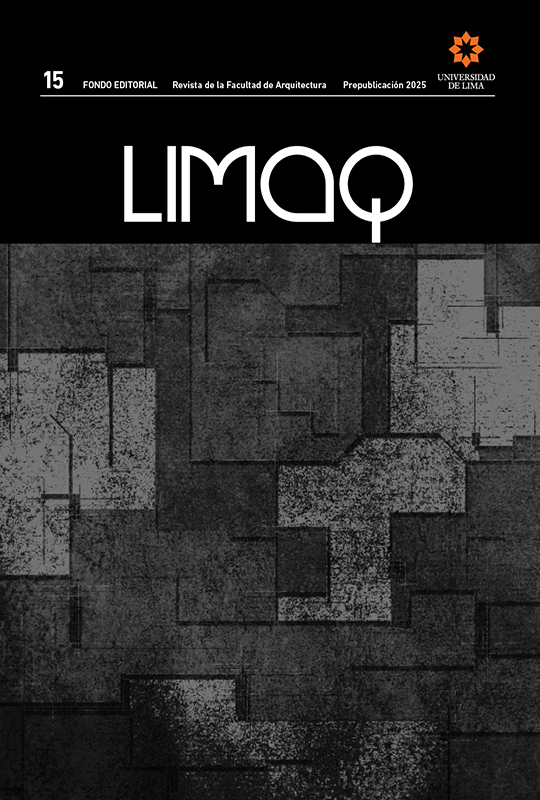La naturaleza del espacio en América: comprendiendo las teorías no eurocéntricas y no antropocéntricas para la arquitectura y el urbanismo
DOI:
https://doi.org/10.26439/limaq2025.n015.7282Palabras clave:
naturaleza, espacio, América, Abiayala, indigeneidad, eurocentrismoResumen
Este ensayo se enfoca en cómo perspectivas alternativas sobre la relación entre los seres humanos y el resto del mundo natural pueden contribuir a la construcción de marcos intelectuales más inclusivos para comprender los paisajes culturales. Mediante una exploración de la producción académica reciente acerca de la decolonización de las teorías de la arquitectura y del urbanismo, se argumenta que el reconocimiento de los patrones de ocupación espacial en América por parte de diversos pueblos indígenas antes de la colonización es un primer paso útil para salir de las formas obstinadas de conocer y dar forma al mundo. El ensayo comienza con un cuestionamiento del nombre de las cosas. En particular, se sostiene que el término naturaleza debe ser desmantelado, ya que es inherentemente eurocéntrico. Asimismo, se describe cómo pensar de manera diferente acerca de la forma en que los pueblos indígenas manipularon plantas y animales de su entorno para producir alimentos y otros materiales útiles puede conducir a nuevas formas de concebir el urbanismo. Finalmente, se examina la tendencia de las teorías eurocéntricas a ser antropocéntricas en muchas disciplinas, y a asociar la colonización y su contraparte oscura, el modernismo, con la mejora progresiva e inevitable de la humanidad.
Descargas
Referencias
Arias, A. (2018). From Indigenous literatures to Native American and Indigenous theorists: The makings of a grassroots decoloniality. Latin American Research Review, 53(3), 613–626. https://doi.org/10.25222/larr.181
Bhambra, G. K. (n.d.). Reframing colonialism and modernity: An endeavour through sociology and literature. The Global South Project at Cornell University. http://www.globalsouthproject.cornell.edu/reframing-colonialism-and-modernity.html
Brown, F. L. (2016). The city is more than human: An animal history of Seattle. University of Washington Press. https://www.perlego.com/book/723876/the-city-is-more-than-human-an-animal-history-of-seattle-pdf
Candiani, S. (2014). Dreaming of dry land: Environmental transformation in colonial Mexico City. Stanford University Press. https://history.princeton.edu/about/publications/dreaming-dry-land-environmental-transformation-colonial-mexico-city
Cardinal-Pett, C. (2015). A history of architecture and urbanism in the Americas. Routledge. https://doi.org/10.4324/9781315691817
Clarke, A. J. (2016). Design for development, ICSID and UNIDO: The anthropological turn in 1970s design. Journal of Design History, 29(1), 43–57. https://doi.org/١٠.١٠٩٣/jdh/epv٠٢٩
Denevan, W. M. (1992). The pristine myth: The landscape of the Americas in 1492. Annals of the Association of American Geographers, 82(3), 369–385. http://www.jstor.org/stable/2563351
Dym, J. (n.d.). [Review of the book Dreaming of dry land: Environmental transformation in colonial Mexico City, by V. S. Candiani]. Amazon. https://www.amazon.com/Dreaming-Dry-Land-Environmental-Transformation/dp/0804788057
Holbraad, M., & Viveiros de Castro, E. (2016). Ideas of savage reason: Glass Bead in conversation with Martin Holbraad and Eduardo Viveiros de Castro. Glass Bead. https://www.glass-bead.org/article/ideas-of-savage-reason-glass-bead-in-conversation-with-martin-holbraad-and-eduardo-viveiros-de-castro/?lang=enview
Illich, I. (1985). H2O and the waters of forgetfulness: Reflections on the historicity of stuff. Dallas Institute of Humanities and Culture. https://www.amazon.com/H2O-Waters-Forgetfulness-Reflections-Historicity/dp/0911005064
Keme, E. (2018). For Abiayala to live, the Americas must die: Toward a transhemispheric Indigeneity (A. Coon, Trans.). Native American and Indigenous Studies, 5(1), 42–68. https://doi.org/10.1353/nai.2018.a704738
Lara, F. L. (2024). Spatial theories for the Americas: Counterweights to five centuries of Eurocentrism. University of Pittsburg Press. https://upittpress.org/books/9780822948339/
Latour, B. (2004). Politics of nature: How to bring the sciences into democracy (C. Porter, Trans.). Harvard University Press. https://doctoradohumanidades.wordpress.com/wp-content/uploads/2015/04/latour-politics-of-nature.pdf
Leiss, W. (1974). The domination of nature. McGill-Queen’s University Press. https://www.mqup.ca/domination-of-nature--the-products-9780228017257.php
Linton, J. (2010). What is water? The history of a modern abstraction. UBC Press. https://www.ubcpress.ca/what-is-water
Lorde, A. (1984). Sister outsider: Essays and speeches. New York University Press. https://books.google.com.pe/books/about/Sister_Outsider.html?id=kE3ek_-FGWgC&redir_esc=y
McNeill, W. H. (1995). The Rise of the West after twenty-five years. In S. K. Sanderson (Ed.), Civilizations and world-systems: Studying world-historical change (pp. 303-319). AltaMira Press.
Mundy, B. E. (2015). The death of Aztec Tenochtitlan, the life of Mexico City. University of Texas Press. https://utpress.utexas.edu/9781477317136/
Pádua, J. A. (2010). The theoretical foundations of environmental history. Estudos Avançados, 24(68), 88. https://www.scielo.br/j/ea/a/Q4JBvrMMzw6gBvWhsshnKXN/?format=pdf&lang=en
Princeton University. (n.d.). Vera S. Candiani. Princeton-Mellon Initiative in Architecture, Urbanism & the Humanities. https://arc-hum.princeton.edu/people/vera-candiani
Scarce, R. (2000). Fishy business: Salmon, biology, and the social construction of nature. Temple University Press. https://books.google.com.pe/books/about/Fishy_Business.html?id=M9jLp13q9jUC&redir_esc=y
Simmons, I. G. (1993). Interpreting nature: Cultural constructions of the environment. Routledge. https://www.routledge.com/Interpreting-Nature-Cultural-Constructions-of-the-Environment/Simmons/p/book/9780415097062?srsltid=AfmBOoqW-23FuOWmqv_w8I9CzN12yH4izBoStom3meqCna6-ZAbPMG41
Soluri, J., Leal, C., & Pádua, J. A. (2018). A living past: Environmental histories of modern Latin America. Berghahn Books. https://doi.org/10.3167/9781785333903
Sörlin, S., & Warde, P. (2007). The problem of the problem of environmental history: A re-reading of the field. Environment History, 12(1), 107–130. https://www.jstor.org/stable/25473035
Stender, M. (2016). Towards an architectural anthropology—What architects can learn from anthropology and vice versa. Architectural Theory Review, 21(1), 27–43. https://doi.org/10.1080/13264826.2016.1256333
Viveiros de Castro, E. (1998). Cosmological deixis and Amerindian perspectivism. The Journal of the Royal Anthropological Institute, 4(3), 469–488. https://doi.org/10.2307/3034157



